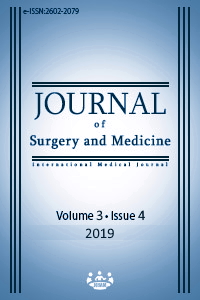Pediatric living donor liver transplantation: A single center experiences
Keywords:
Pediatric patient, Living donor liver transplantationAbstract
Aim: The only definitive treatment of chronic liver disease (cholestatic, metabolic, autoimmune), acute liver failure and liver tumors are liver transplantation in pediatric patients. The aim of this study was to present the experience of our center on pediatric living donor liver transplantation and review of the literature.
Methods: This is retrospective cohort study. Pediatric patients who receive living donor liver transplantation between December 2014 and December 2017 included in the study. Demographic features, complications after transplantation, and mortality rates were recorded.
Results: A total 29 patients were included in the study. Mean age of cases were 3.1 (1-13) years, 18 (62.1%) of the patients were male. Mean Pediatric End-Stage Liver Disease (PELD) scores were 15.6 (-6-37). Mean follow-up period was 60 months. Complication was detected in 11 patients (37.9%) and 5 patients died (mortality rate: 17.9%). In our study, the causes of death were disseminated intravascular coagulation in three patients and sepsis due to biliary leakage in two patients.
Conclusion: Complications and mortality rates related to pediatric patients with donor liver transplantation in our center are consistent with the literature.
Downloads
References
Starzl TE, Marchioro TL, Vonkaulla KN, Hermann G, Brittain RS, Waddell WR. Homotransplantation of the liver in humans. Surg Gynecol Obstet. 1963;117:659–76.
Larosa C, Baluarte HJ, Meyers KE. Outcomes in pediatric solid organ transplantation. Pediatr Transplant. 2011;15:128–41.
Tiao G, Ryckman FC. Pediatric liver transplantation. Clin Liver Dis. 2006;10:169–97.
Otte JB. Pediatric liver transplantation: personal perspectives on historical achievements and future challenges. Liver Transpl. 2016;22:1284–94.
Squires RH, Ng V, Romero R, Ekong U, Hardikar W, Emre S, et al. Evaluation of the pediatric patient for liver transplantation: 2014 practice guideline by the American Association for the Study of Liver Diseases, American Society of Transplantation and the North American Society for Pediatric Gastroenterology, Hepatology and Nutrition. Hepatology. 2014;60:362–98.
Tiao G.Liver transplantation. In: Maritz R GA, Ziegler M, Von Allmen Daniel, Weber Thomas R, editors. Operative Pediatric Surgery. 2014;1:1397.
Yazigi NA. Long term outcomes after pediatric liver transplantation. Pediatr Gastro enterol Hepatol Nutr. 2013;16:207–18.
Sundaram SS, Mack CL, Feldman AG, Sokol RJ. Biliary atresia: Indications and timing of liver transplantation and optimization of pretransplant care. Liver Transpl. 2017;23:96–109.
Davenport M, Ong E, Sharif K, Alizai N, McClean P, Hadzic N, et al.Biliary atresia in England and Wales: results of centralization and new bench mark. J Pediatr Surg. 2011;46:1689–94.
Rajanayagam J,Coman D,Cartwright D,Lewindon PJ. Pediatric acute liver failure: etiology, outcomes, and the role of serial pediatric end-stage liver disease scores. Pediatr Transplant. 2013;17:362–8.
Kerr DN, Harrison CV, Sherlock S, Walker RM. Congenital hepatic fibrosis. Q J Med. 1961;30:91–117.
Shorbagi A, Bayraktar Y. Experience of a single center with congenital hepatic fibrosis: a review of the literature. World J Gastroenterol. 2010;16:683–90.
Arnon R, Annunziato R, Schiano T, Miloh T, Baisley M, Sogawa H, et al. Orthotopic liver transplantation for adults with Alagillesyndrome. Clin Transplant. 2012;26:94–100.
Mehl A, Bohorquez H, Serrano MS, Galliano G, Reichman TW. Liver transplantation and the management of progressive familial intrahepatic cholestasis in children. World J Transplant. 2016;6:278–90.
Oishi K, Arnon R, Wasserstein MP, Diaz GA. Liver transplantation for pediatric inherited metabolic disorders: Considerations for indications,complications,and perioperative management. Pediatr Transplant. 2016;20:756–69.
Brown J, Perilongo G, Shafford E, Keeling J, Pritchard J, Brock P, et al. Pretreatment prognostic factors for children with hepatoblastoma results from the International Society of Paediatric Oncology (SIOP) study SIOPEL1. Eur J Cancer. 2000;36:1418–25.
D'Alessandro AM, Ploeg RJ, Knechtle SJ, Pirsch JD, Stegall MD, Hoffmann R, et al. Retransplantation of the liver—A seven-year experience. Transplantation. 1993;55:1083-7.
Shackleton CR, Goss JA, Swenson K, Colquhoun SD, Seu P, Kinkhabwala MM, et al. The impact of microsurgical hepatic arterial reconstruction on the outcome of liver transplantation for congenital biliary atresia. Am J Surg. 1997;173:431-5.
Bucuvalas J. Long term outcomes in pediatric liver transplantation. Liver Transpl. 2009;15:6–11.
Ng VL, Fecteau A, Shepherd R, Magee J, Bucuvalas J, Alonso E, et al. Outcomes of 5-year survivors of pediatric liver transplantation: Report on 461 children from a North American multicenter registry. Pediatrics. 2008;122:1128–35.
Allamneni C, Kyanam Kabir Baig K, Gray S, Peter S. Bleeding at Roux-en Y jejunojejunal anastomosis after orthotopic liver transplantation. VideoGIE. 2018 May 2;3:179-80.
Kim JM, Kim KM, Yi NJ, Choe YH, Kim MS, Suh KS, et al. Pediatric liver transplantation outcomes in Korea. J Korean Med Sci. 2013 Jan;28(1):42-7. doi: 10.3346/jkms.2013.28.1.42.
Downloads
- 1164 1574
Published
Issue
Section
How to Cite
License
Copyright (c) 2019 Gökhan Ertuğrul, Burcu Hızarcı
This work is licensed under a Creative Commons Attribution-NonCommercial-NoDerivatives 4.0 International License.
















